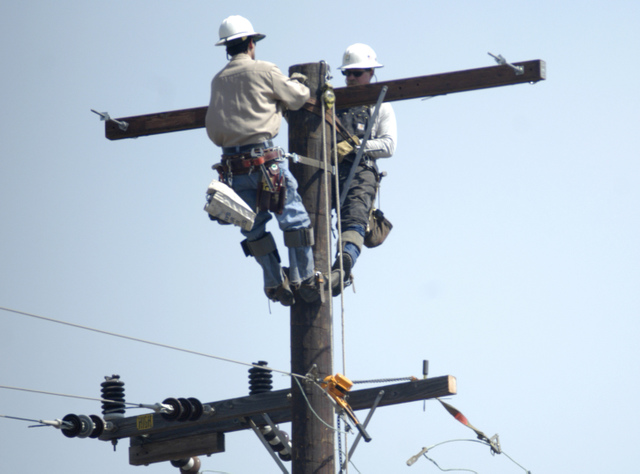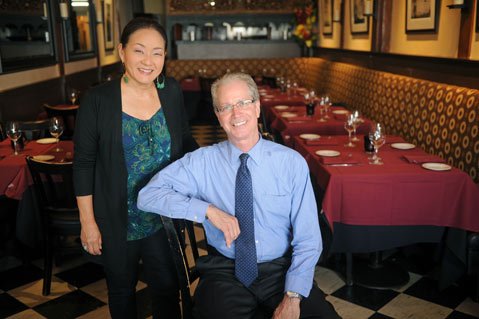Power Outages Spark Outrage
Business Owners Push and Prod Edison to Upgrade Crumbling Equipment

The fizzling patience of Santa Barbara business owners finally popped this week after another recent bout of downtown blackouts. Complaining that the outages have cost them dearly and that Southern California Edison isn’t doing enough to keep the lights on, a group of bar and restaurant owners is circulating a petition to prioritize equipment upgrades and repairs in their area.
The owners of Opal Restaurant & Bar and Olio E Limone Ristorante spearheaded the petition addressed to Edison president Pedro Pizarro. As of Tuesday night, 28 more people along State Street’s influential business core had signed on, including bankers, retailers, and hoteliers. Many left pointed comments. Edison representatives promised this week that the utility company is “committed to focus on the downtown as a 2015 priority,” but the commercial interests continue to push fast and hard for clear answers and concrete plans.
On October 2 and 3, back-to-back blackouts hit the city. Tony Bennett’s concert at the Granada Theater was cancelled, First Thursday events were scrapped, traffic snarled, alarms sounded, and those eating and drinking around State Street went home. One bar owner estimated he lost around $20,000 over the course of the weekend. “One or two more of those, and I’m out of business,” he said. That episode brought the issue to a head after months of grumbling over a perceived uptick in outages.
In response to those cries, Edison dispatched three of its corporate heavies to speak at recent Downtown Organization (DO) and Chamber of Commerce meetings. They presented circuit maps and reliability reports, and explained that while Santa Barbara was one of their worst performing districts in 2008 in terms of blackout frequency and duration, steady upgrades to the area’s aging infrastructure buoyed it to one of their best in 2013. Edison serves 35 defined districts throughout Southern California. Santa Barbara’s, which stretches from the Ventura County border up to Gaviota, is at the end of the company’s transmission line before PG&E takes over.
The meetings’ attendees said they appreciated the dialogue, but real concerns lingered. One participant said he was actually left “more scared” by what he learned. Numbers for 2014 were not (and are still not) available, so anecdotal claims of more blackouts this year compared to last year couldn’t be vetted. And Edison wouldn’t budge from its rigid approach to improvement work on and around the six downtown circuits, the business owners complained. Instead of robotically allocating resources to one of the other 33 city circuits if it shows more problems, they argued, Edison should give the commercial corridor precedence because through it flows Santa Barbara’s lifeblood.

In an email announcing the petition and delivered to around 1,000 inboxes the day after Christmas, Opal co-owner Richard Yates said Edison’s Santa Barbara customers are “extremely unhappy and need to see something done about [the outages] quickly, with the urgency that public safety and our economic livelihoods calls for, not the methodical plodding schedule their corporate practices keep them mired in.” While residential blackouts are a headache, the petition reads, “business failures should be much more highly weighted and more urgently addressed.”
During interviews this week, Yates and others pointed to refrigeration problems when the power goes out, lost wages for their staff, and potential liability should a customer get hurt. At home, you can just light a candle, they said. A number of business owners have submitted claims to Edison after outages in an attempt to recoup lost earnings, but they’ve been universally denied. Some have since taken up their claims with insurance companies. Others are investing in backup generators.
Underlying much of the discontent is a belief, real or imagined, that Edison gives Santa Barbara short shrift not only because it’s at the edge of the company’s coverage zone, but also because the city is not expanding the way many SoCal communities are these days, and so is not an attractive area for investment. Before the meetings, Edison removed itself from the good graces of DO members when it refused to cover the cost of the downtown Holiday Tree for the first time in years.
Yates said while he and his cohorts understand when an act of God kills power — i.e. an earthquake, fire, or rainstorm — they don’t get why Edison is always let off the hook by simply citing “equipment failure.” “That just means they aren’t maintaining their equipment properly,” he said. Last year, broken transformers, switches, and conductors accounted for 61.8 percent of blackouts; tree branches and animals led to 9.9 percent of them; and fire and weather were responsible for 6.6 percent of the incidents.
The city’s underground electric systems were some of the first in the region to go subterranean 50-plus years ago. While burying transformers and other gadgetry is nice for aesthetics — and is currently mandated by city code — it presents maintenance and repair challenges when water and debris get into the vaults. Edison is primarily an overhead utility. Given downtown’s tight quarters, putting a transformer above ground often means negotiating with a property owner or exploring land acquisition options.
City Administrator Paul Casey said he and others have been working to facilitate meetings between Edison and downtown merchants, explaining, “We share the frustration of the business owners about getting more consistent reliability.” Thankfully, he went on, Santa Barbara and Edison enjoy a good working relationship and so are collaborating on fixes both quick and long-term. Chamber president Ken Oplinger echoed those sentiments and took a similarly tempered tone. “I think everyone has been really positive about trying to find a solution,” he said.
In a lengthy interview with The Santa Barbara Independent, Edison public affairs director Cathy Hart, who also spoke at the DO and Chamber meetings, said the company “really appreciated the opportunity to hear customer concerns” and was “glad to bring good news to the Santa Barbara community.”
She cited improved reliability numbers since 2008 — that year, the average Santa Barbara district customer experienced 6.3 sustained power outages (longer than five minutes) and was left in the dark for a cumulative 535.5 minutes. By 2013, those numbers dropped to 0.70 and 82, respectively. But, Hart admitted, it may be tough for those working within circuits that are currently “acting up” to believe such positive reports.
Hart said Edison is devoting considerable time and money in the coming years to replacing old equipment along State Street and beyond. Right now, engineers are planning specific projects and bearing down on problem areas, she went on. (Details on those efforts were not available.) Already since 2012, Hart said, serious circuit rehab has taken place with 57,682 feet of fresh cable, 266 new power poles, and 159 replaced transformers. She couldn’t attach a dollar figure to the local work, but noted Edison tripled its overall “infrastructure replacement program” last year to $20 billion.
Hart gently balked at the insistence that Edison’s prioritization strategy is “corporate” and “inflexible” and instead described their data-driven approach as “systematic” and “methodical.” “If we could wave a magic wand everywhere tomorrow, we’d certainly do that,” she said. “But it takes time to plan this work, to get the permits we need.” The company’s overriding policy is to replace a piece of equipment before it fails. “That’s not always the case,” Hart went on, “but that’s the goal.” The planned replacement of an unground switch costs $49,400, while an emergency replacement costs $67,600, she noted.
The October 2 and 3 outages were “very unfortunate” and “untimely,” Hart said. They affected more than 20,000 customers. She explained they were the result of an “unexpected equipment failure,” but that the incident “did not allow for reimbursement of claims.” Hart said she couldn’t think of an example of when Edison would reimburse a business for losses it sustained during an unplanned blackout. That kind of policy “is not unique to Edison,” she said. Had the outages occurred elsewhere in the Santa Barbara district, the backlash against Edison may not have reached such a “fever pitch,” Hart speculated. Conspicuously absent from any of the conversations were the interests of Milpas Street merchants, who were also hit by the October shutdowns.
Edison’s newly sharpened focus on the State Street corridor was not entirely driven by complaints, Hart went on. The company “probably did have work scheduled” in the area already. “We want to be good partners with our customers,” she said. “Their input is helpful for us.” A few residential customers may get some collateral benefit from the improvement work if they happen to live on one of the prioritized circuits, Hart said.



